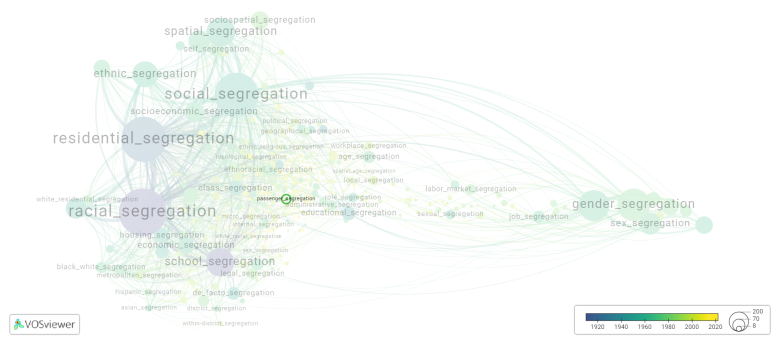Passenger segregation: Difference between revisions
(Creating page) |
(Creating page) |
||
| Line 18: | Line 18: | ||
[[File:passenger_segregation.png|780x780px]] | [[File:passenger_segregation.png|780x780px]] | ||
This visualization is based on the study [[ | This visualization is based on the study [[Segregation_Wiki:About| The Multidisciplinary Landscape of Segregation Research]]. | ||
For the complete network of interrelated segregation forms, please refer to: | For the complete network of interrelated segregation forms, please refer to: | ||
Latest revision as of 07:17, 16 October 2024
Date and country of first publication[1][edit | edit source]
1989
South Africa
Definition[edit | edit source]
Passenger segregation refers to the practice of separating individuals based on their race, ethnicity, or other characteristics, within certain spaces or facilities, particularly in transportation systems. This practice has historically been used to enforce racial or social hierarchies and maintain racial or ethnic separation.
Passenger segregation has been employed in various transportation systems, including buses, trains, and airplanes. It has been particularly associated with the era of racial segregation in the United States during the 19th and 20th centuries, where laws mandated separate seating or designated areas for Black and White passengers.
In the United States, the groundbreaking legal case of Brown v. Board of Education in 1954 ruled that segregation in schools was unconstitutional. This landmark decision had far-reaching implications for the dismantling of segregation in other areas, including transportation. Following the Civil Rights Movement and passage of the Civil Rights Act of 1964, the practice of passenger segregation was officially abolished in the United States.
While passenger segregation is no longer legally mandated in many countries, there are instances of de facto segregation or discrimination based on race or ethnicity that can occur in certain transportation systems or settings. Efforts are ongoing to ensure equal treatment and eradicate any forms of discrimination in transportation.
See also[edit | edit source]
Related segregation forms[edit | edit source]
Passenger segregation is frequently discussed in the literature with the following segregation forms:
This visualization is based on the study The Multidisciplinary Landscape of Segregation Research.
For the complete network of interrelated segregation forms, please refer to:
References[edit | edit source]
Notes[edit | edit source]
- ↑ Date and country of first publication as informed by the Scopus database (December 2023).
At its current state, this definition has been generated by a Large Language Model (LLM) so far without review by an independent researcher or a member of the curating team of segregation experts that keep the Segregation Wiki online. While we strive for accuracy, we cannot guarantee its reliability, completeness and timeliness. Please use this content with caution and verify information as needed. Also, feel free to improve on the definition as you see fit, including the use of references and other informational resources. We value your input in enhancing the quality and accuracy of the definitions of segregation forms collectively offered in the Segregation Wiki ©.
Passenger segregation appears in the following literature[edit | edit source]
Pirie G.H. (1989). A most difficult and delicate question: racial segregation on the Central South African Railways, 1902 10. Journal of Transport History, 10(2), 113-127. https://doi.org/10.1177/002252668901000204

